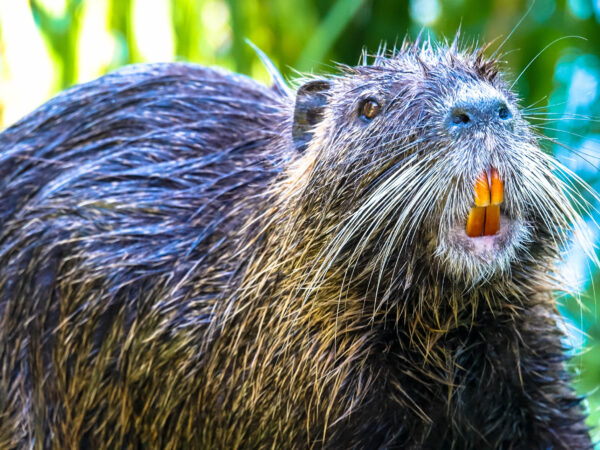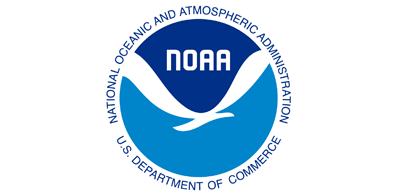
Nutria (Myocastor coypu)
Species at a Glance
The Nutria, also called the Coypu, is a large, semi-aquatic rodent that was once considered an important resource for the Louisiana fur industry. With the collapse of the fur market in the 1940s, the Nutria became overabundant and affected thousands of acres of coastal wetland as it grazed on important marsh vegetation.
Species Description
Often mistaken for beavers and muskrats, the Nutria is a furry swimming rodent that can weigh 15-20 lbs and reach 2 ft (0.6 m) long. It is usually dark brown with a large head, short legs, and a stout body that appears hump-backed on land. Its large front teeth can range from yellow to orangish-red. Highly adapted for aquatic ecosystems, the Nutria has partially webbed hind feet, and its eyes, ears, and nostrils are set high on the head, enabling it to stay above the waterline while swimming. There are two ways to differentiate Nutria from a beaver or muskrat. The first is to look at the body size. The Nutria is about one-third the size of an adult beaver, and 5 to 8 times larger than an adult muskrat. The second way is to observe the tail. The Nutria’s tail is heavy, yet thin, and covered with bristly hairs that trail smoothly behind it when swimming. The beaver’s tail is large, broad, and flat, and the muskrat’s tail is long, narrow, and it whips back and forth when swimming.
Native & Introduced Ranges
Native to South America, the Nutria was introduced into the United States in 1899 to establish a fur farming industry in California. Although this initial introduction failed, subsequent introductions to Louisiana, Ohio, New Mexico, Michigan, Oregon, Utah, and Washington led to accidental and intentional releases that have enabled this species to spread throughout the United States, with the largest populations located in coastal areas along the Gulf Coast. There are no established populations of Nutria in Pennsylvania.
Biology & Spread
After the collapse of the fur market, thousands of Nutria were released into the wild by ranchers who could no longer afford to feed and house them. In some areas, it was also released by state agencies to control problem plants like Water Hyacinth and Alligator Weed. Other than annual fur harvesters, alligators are the only significant predator of the Nutria; however, even in areas with an abundance of alligators, it can thrive if habitat conditions are suitable. The Nutria is highly prolific, reaching sexual maturity at six months of age and producing at least two litters of 4-5 young in one year.
Habitat
The Nutria has adapted to a wide range of habitats and is usually found living along lakes, marshes, slow-moving streams, and in freshwater, brackish, or saltwater marshlands. It tends to prefer habitats with an abundance of emergent vegetation and small trees, shrubs, and other succulent vegetation along the banks. In cities, it can be found under buildings, in overgrown lots, on golf courses, and in storm drains.
Impacts
Threat to Biodiversity
High concentrations of Nutria can severely damage wetland ecosystems and native plant species. It feeds predominantly on the base of plant stems but will dig for roots and rhizomes in the winter. This grazing can strip large patches of marsh, destroying— sometimes permanently—the plants that hold together the marsh soils that sustain coastlines and support the survival of native species. The destruction of these marshlands also increases the vulnerability of adjacent upland sites to erosion and flooding during storms.
Economic Costs
The burrowing behavior of the Nutria can weaken the foundation of important infrastructure such as reservoir dams, buildings, roadbeds, and flood control levees that protect low-lying areas. Grazing has damaged important economical crops such as sugarcane, rice, corn, and various kinds of fruits and vegetables, resulting in significant economic losses for farmers. Anglers and local industries also suffer when the degradation of wetland spawning areas results in decreased catches of shrimp, crab, and fish.
Health Risks
The Nutria can threaten public health and safety because it serves as hosts for several pathogens and parasites such as tuberculosis, septicemia, blood flukes, and tapeworms, which can contaminate drinking water supplies and swimming areas.
Prevention & Control
It is best to control the Nutria where it is concentrated and most active. While trapping, poisoning (currently zinc phosphide is the only chemical approved for nutria) and shooting are controversial, they offer direct methods of control. Indirect methods include exclosures like fences or walls, rodent repellents, seedling protection, and aromatic plantings. Intensive trapping is useful for removing Nutria from localized areas, and when applied strategically, can eliminate populations across large areas provided the risk of reinvasion is manageable. However, due to low fur prices, recreational or commercial harvest is generally insufficient to control populations.
References
United States Department of Agriculture: Wildlife Services. 2010. Nutria, and Invasive Rodent. Factsheet. http://www.aphis.usda.gov/publications/wildlife_damage/content/printable_version/fs_nutria10.pdf
Burk, P.W., Witmer, G.W., Jojola, S.M. and Nolte, D.L. 2008. Improving Nutria Trapping Success. Proceedings of the 23rd Vertebrate Pest Conference. San Diego, California. < http://naldc.nal.usda.gov/download/23404/PDF>
United States Geological Survey. 2000. Nutria, Eating Louisiana’s Coast. Factsheet. < http://www.nwrc.usgs.gov/factshts/020-00.pdf>



